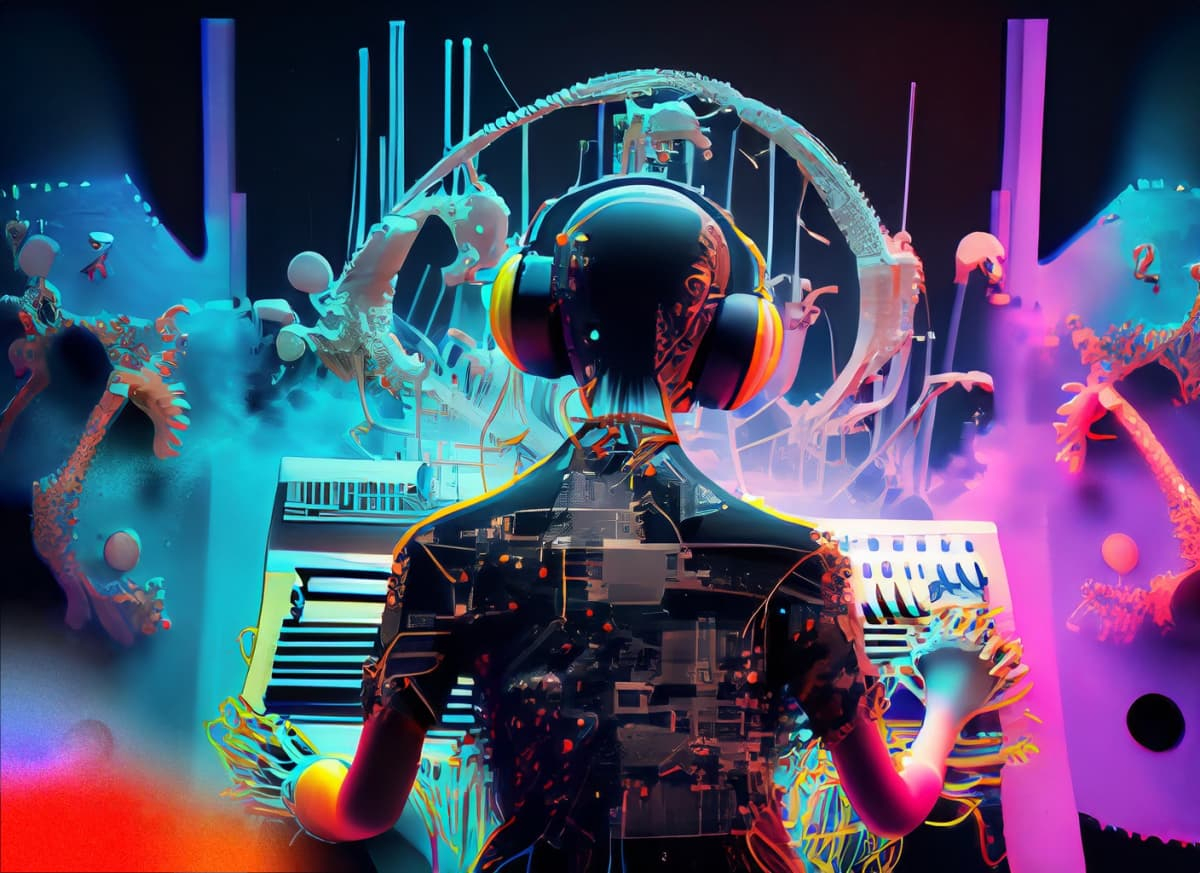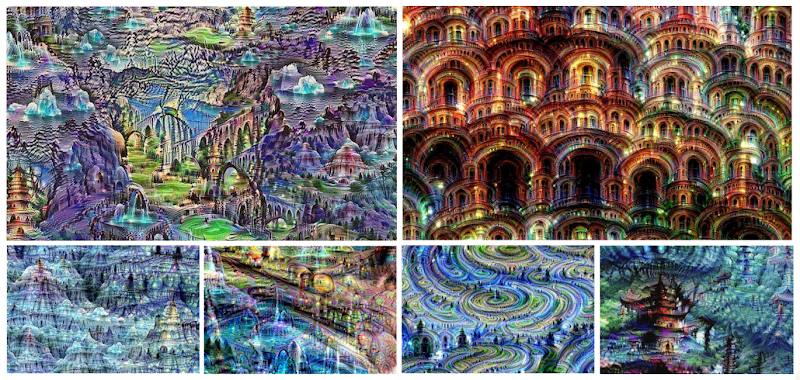The role of AI in art and music industries
Saanjh Balpande • 2024-07-18
Decades of digital innovation, from the web's birth to ubiquitous smartphones, have propelled us into a new era. We interact differently now – with each other, machines, and even art. Artist Roy Ascott argues this digital revolution challenges our core understanding of humanity – creativity, perception, and even what it means to be human itself.
From the invention of the World Wide Web thirty years ago, to the various technological developments that have come to frame our daily lives, we have left the analogue era to fully emerge in a digital modernity that has allowed us to reimagine the way we interact with each other, machines, and art. As best described by cybernetics artist and art theorist Roy Ascott, the 1 recent technological advancements are calling into question the very nature of what it is to be human, to be creative, to think and to perceive, and indeed our relationship with each other and the planet as a whole. Algorithms evolve to continuously revamped, elaborate and mature structures, and force us to inevitably discuss subjects that were previously exclusively assigned to humans such as agency, creativity, intentionality, and artistic expression.
AI Art in the Context of Culture Studies
In discussing an interdisciplinary topic that draws on theoretical support from computer science, sociology, psychology, and philosophy, this research focuses on subjects that should be primarily framed through key theories of Culture Studies. One common theme between the subject of this thesis and the field is the evaluation of AI as a technological tool used expressively in contemporary culture and art.
In essence, a work of art has always been reproducible. People could always imitate man-made artifacts. Replicas were created by apprentices in the practice of their craft, by masters to spread their works, and by others for profit. However, the mechanical reproduction of a work of art represents something new. Historically, it progressed intermittently and in leaps at long intervals but with accelerated intensity.
Considering the modern historical circumstances of the information age we live in, it is undeniable that the conditions created by AI highly complicate the unique existence of artwork in a specific place at a particular time. Consequently, what Benjamin defined as the artwork's aura becomes increasingly abstract in our time and with contemporary tools, as they constantly change.
This lightness of the modern era allows for a somewhat perfect fit metaphor with the nature of software and artificial culture. For both, speed becomes often the absolute prerequisite to signify technological excellence.
The very idea of speed (even more conspicuously, that of acceleration), when referring to the relationship between time and space, assumes its variability, and it would hardly have any meaning at all were not that relation truly changeable, were it an attribute of inhuman and pre-human reality rather than a matter of human inventiveness and resolve. Once the distance passed in a unit of time came to be dependent on technology, on artificial means of transportation, all extant, inherited limits to the speed of movement could be in principle transgressed" (Bauman, 2000, p.9).
The impact of artificial means of production on the concepts of time and space, as well as on the unique existence and originality of artwork, is a critical consideration. Bauman's idea of instantaneity and liquidity in modern conditions can be applied to artificially produced artworks, allowing us to examine the influence of AI data content and processing speed under the constantly changing nature of algorithm functions.
When AI is used as an artistic tool, data becomes the source of reproduction. Technology has made personal belongings intangible and has also made data more flexible. According to Guy Debord's "Society of the Spectacle," modern production conditions have caused life to be viewed as a collection of representations rather than direct experiences. These representations of our lives, such as pictures, data, conversations, and transactions, serve as the basis for AI systems to enhance their capabilities and understanding. But how is this information categorized and labelled for use as visual references in the AI's learning process?
We must inevitably explore the semiotics of data tagging and categorization to understand the technical process of AI. This exploration raises issues linked to individual prejudices and perceptions that are immortalized in databases shared and repetitively used to "train" machine learning models.
While exploring art production, it's crucial to examine how individuals influence data labelling. This research should address the potential risks related to gender and racial diversity. Judith Butler's examination of gender and language within power structures highlights the significant connection between hidden stereotypes in databases and the gendered classification of subjects. These stereotypes often go unnoticed due to the absence of an author, creating an artificial shadow. Eventually, cultural discourses will allow us to look into the new profile of artists working with code in a digital and globalized world. As artworks created through AI methods of production inevitably go beyond mere reproductions and instead rely on machine speed, data, and algorithmic structure to produce visual results, the makers' role is also evolving.
Computational art in diverse applications
Algorithms are not independent of the people who design and refine them. Therefore, in recent years, we have witnessed an increase in various artistic experiments testing the latest developments in AI towards creative and cultural outcomes, including the production of music, visual arts, and performing arts.
Likely the most rapidly known application of AI in a cultural context was the algorithm "Deep Dream," published by Google as open-source in 2015. An open-source program is software for which the original code is published and can therefore be altered or used for free by anyone for any purpose. The algorithm in question was designed by Google engineers to first recognize visual patterns in pictures and then create an image loop that would repeat these patterns, as shown in the compilation of images below.
If one were to take a closer look at the images produced using the original DeepDream, one would notice a recurring pattern of dogs, particularly dog eyes. The unconventional occurrence can be attributed to the dataset utilized for training the model. As per reports from Fast Company, the data was sourced from ImageNet, a database developed by researchers at Stanford and Princeton, housing a compilation of 14 million human-labeled images.
The Digital Metamorphosis of Art: Fluidity, Reproduction, and AI
In our fast-evolving digital era, the essence of artwork is undergoing a significant transformation. Walter Benjamin's concept of an artwork's "aura" - its distinct presence in time and space - becomes increasingly abstract as artificial intelligence revolutionizes creative processes. Zygmunt Bauman's theory of "liquid modernity" serves as a fitting metaphor for this change, reflecting the fluidity of software and artificial culture. Just as Bauman describes the fluidity of time and space in contemporary conditions, AI-generated art surpasses traditional boundaries of originality and reproduction. The instantaneous and fluid nature of data in AI systems resonates with Bauman's observations on the acceleration of modern life. This new paradigm challenges our perception of artistic authenticity and raises intricate questions about the nature of creativity in an era where artificial methods of production blur the lines between human and machine-made art.
The Labyrinth of Data: AI's Semiotic Quandary in Art
As we continue to advance in the digital age, the complex interaction between artificial intelligence and artistic expression raises significant questions about the essence of creativity and human ingenuity. The process of labelling and categorizing data in AI systems has become a contentious issue, as it brings to light concerns about individual biases and perspectives that are perpetuated within the extensive databases utilized to train machine learning models. This seemingly routine digital labelling process carries the weight of societal prejudices, particularly in terms of gender and racial diversity. Drawing parallels to Judith Butler's influential analysis of gender and language within power structures, we are forced to confront the uncomfortable truth that these underlying biases in AI databases may reinforce and exacerbate existing inequalities, all while camouflaged within the facade of an ostensibly impartial, authorless system.
The Artist's Evolution: Navigating Creativity in the AI Era
As we stand on the brink of a new era in art, the role of the artist is experiencing a significant transformation. Computational art has made its mark in various creative fields, from the evocative melodies of AI-generated symphonies to the striking visuals of machine-produced paintings. It's important to bear in mind that these algorithms, no matter how advanced, are ultimately crafted by human intellect. This fusion of human creativity and artificial intelligence is reshaping the landscape of artistic expression. Consider the ground-breaking "Portrait of Edmond de Belamy," an AI-generated artwork that fetched a remarkable $432,500, challenging our notions of authorship and value in art. Also, look at AIVA, an AI music composer creating evocative symphonies that can rival human-made compositions. These instances shed light on the intricate interplay between human innovation and machine capability, compelling us to re-evaluate the boundaries of creativity and the very essence of being an artist in this bold new world.
Sources:
De Cremer, David. "How Generative AI Could Disrupt Creative Work." Harvard Business Review, 13 April 2023, https://hbr.org/2023/04/how-generative-ai-could-disrupt-creative-work.
Clark, Elijah. "The End Of Originality: Is AI Replacing Real Artists?." Forbes, 23 December 2023, https://www.forbes.com/sites/elijahclark/2023/12/23/the-end-of-originality-is-ai-replacing-real-artists/.
Epstein, Michael. "How Will AI Impact The Future of Music?" Complex, Complex Media, Inc., 16 July 2024, www.complex.com/pigeons-and-planes/a/michael-epstein/how-will-ai-change-the-music-industry.
See More Posts
Copyright © 2021 Govest, Inc. All rights reserved.



